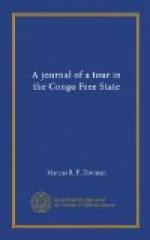After a walk of about a mile, we arrive at the place where the captain’s boy was supposed to have killed the hippo. The truth was he had fired at a beast who, as the spoor clearly showed, had walked calmly into the river and not a trace of blood could be seen. After a time, with practice perhaps, one will be able to gauge the truth from an ordinary Congo statement.
Next day we reach the mouth of the Kasai, a large tributary which drains much of the Equatorial District of the Congo. Here is a State Post, Kwamouth, with a few well constructed houses and a Catholic Mission where pretty walking sticks with ivory handles can be purchased and where the Fathers make a few cigars from Congo tobacco which are not at all bad smoking. A little further up the river, is the deserted Catholic Mission of St. Marie which has evidently been at one time well arranged with a large manioc plantation and garden. Here however, the Sleeping Sickness appeared and the mortality was so heavy that the place was abandoned. The disease had no doubt existed before, but it was this terrible epidemic which first attracted the serious notice of Europeans.
It is becoming clear that there are a great number of nationalities represented in the Congo. Most of the political and military appointments are held by Belgians, but there are many Italian military officers also. Nearly all the marine are Scandinavians and the language of the river is therefore, chiefly English, although every State official must speak a certain amount of French. A few Germans also hold appointments, and the trading houses are run chiefly by English and Dutch, while there are missionaries of several nationalities. In the army, orders are given in French, but on the ships and in the stations, the native is commanded in a kind of jargon based on the Bangala dialect. The Danish captain of a Congo steamer thus as a rule, speaks, besides his own language, English, French and Bangala and can make himself understood in all.
On pay day, rolls of brass wire are cut up into mitakos, which become longer the higher one travels up the river, this arrangement having been introduced by Stanley and never altered. Here the mitako is 28 centimetres long and it is worth 5 cents, while at Basoko it is 40 centimetres long and worth 10 cents. The native crew are paid three mitakos for their food per day which would purchase twice as much kwanga as they could possibly eat. The capitas and wheelman are also paid monthly wages which vary with the nature of their work.
By July 28th we have passed through the Channel into a portion of the river which is very wide and has the appearance of a great lake studded with islands. The banks are invisible, for the country here is absolutely flat and continues so for many hundreds of miles until the Province Orientale is reached. Between these islands, which are usually well wooded, we pass slowly up the river, for the current is still strong although




